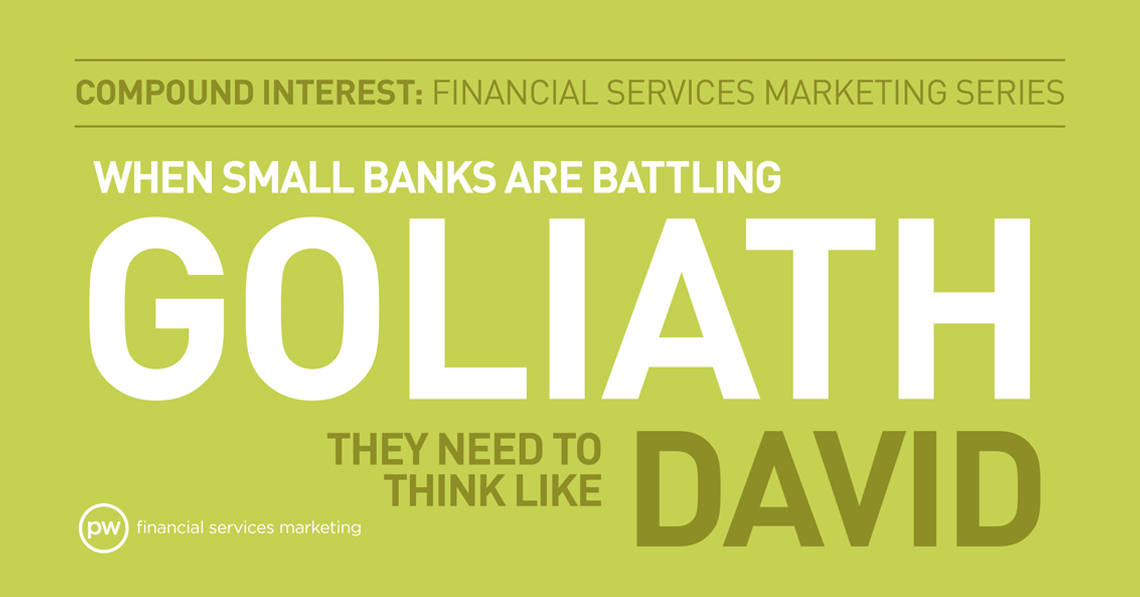Community and regional banks facing competition from the bigger money center banks need to know how they can compete effectively and win. If they try to fight the same way as the giants, they will get overpowered and definitely overspent. But if they think like a smaller bank, they’re nimble and responsive enough to compete successfully. So, how do smaller banks prevail? They think like David.
Goliath had state-of-the-art technology: a big shield, a big spear, a big helmet, plus his own shield bearer and a big supporting cast. In similar fashion, big banks have big leading-edge websites and apps, with tons of tech features, chatbots, downloads and links. But not all of these technology features are viewed as essential by customers. They’re just extras.
As a nimble bank, you can think like David and pick your battles. You have a lot going for you – agility, responsive, personal service, superior local decision-making and a personality that connects with your customers in a way the bigger institutions can’t match. You can be there for your customers with genuine care and a neighborly connection when the big banks can’t. And because you’re intentionally not intimidating, many people will prefer dealing with you. You’re down to earth, friendly and accessible. Most people like David, but they fear Goliath. So, if you provide the service they want, many of them would rather do business with you.
The typical U.S. adult has had the same primary checking account for about 14.3 years, according to a survey conducted for Bankrate and MONEY. This low turnover means people aren’t looking to change banks. They are content with their local banks and are not likely to be looking to make a change. So, your products need to be competitive, not overpowering. Each of your customers probably knows they can open an online only account tomorrow with a better interest than what you offer. They know that with a brick-and-mortar presence and the people to staff it, you will never have the “best” rates, but they don’t expect you to. Your rates just need to be competitive (middle-third to maintain customers and top-third to acquire new).
Your customers aren’t doing business with you because you have a behemoth website (in fact, many don’t like the complexity). They are doing business with you because you are local, convenient and you know their names. When they phone you, a real person answers. When they go into a branch and are treated with dignity, they feel appreciated. They want to come back. Their emails are responded to promptly and personally. Never underestimate the power of the personal touch.
If your small bank has tech basics like online banking and billpay, ATM access and standards for responsiveness, then relax – that’s good enough. Nobody is looking for the perfect ATM experience. They just want access to their money.
Likewise, your customers paying their bills online aren’t thinking of all the ways the process could be more efficient. They just need their online bill-paying experience to work.
The big banks will offer many more bells and whistles, but not to worry – they are not essential, and it does not impact your ability to provide better service to your customers.
Your Sling May Be Small, but It’s Effective.
Like David, just make sure your sling is loaded.
The first stone for your sling is service. Service can be a real advantage that your bank needs to focus on and that’s where you should invest – on tellers, bankers and customer service people. Invest in onboarding new customers and in measuring customer satisfaction, rather than spending on developers or new technology. The payoff comes from providing customer satisfaction in face-to-face transactions and not from trying to impress them with big tech.
The second stone in your sling is local decision-making. Make sure you empower your local teams with the authority necessary to outmaneuver the competition, who is managed by process at a distance and not by empowerment. Empower your retail teams to make decisions about overdrafts and check clearing. Empower your small business teams with lending authority. Empower your commercial teams to make decisions about lending timelines, covenants and terms. It will pay big dividends.
Local decision-making is important to consumers looking for a mortgage and business owners looking for a line of credit. Business owners cite timely decisions, accessibility, responsiveness and better communications as deciding factors when choosing a bank to work with. There is a generally believed notion that larger banks have a broader product offering, but that is not the case. Local banks with local decision-making can have much more flexibility and ability to be creative in designing custom solutions for companies.
One great example is a local third-generation company that was looking to buy a building during the 2009 recession. The owners did not want to personally guarantee the loan. They did have paid-up whole life insurance policies on the previous generation of owners. Only the local bank would offer them a non-personally guaranteed loan using the insurance policies as collateral. And from this, they won a good customer for life.
Your third stone is real people. As you provide ATMs and online banking, make sure to complement them with the option to transact with people. Real people make the human connection, create your brand and deliver real convenience. So, be sure to staff your branches strategically.
Finally, since you’re competing on service and accessibility, use your brick-and-mortar creatively. Consider sub-letting the space with a local retailer that will drive foot traffic, such as coffee shops, donut shops and other family businesses that help defray real estate expense while still providing personal access. This model has worked so well, that big banks are trying to duplicate it and is why Capital One Cafés are now in dozens of markets.
As reported in a 2018 American Banker article, Citizens Bank of Edmond in Oklahoma with two branches and Lead Bank in Garden City, Missouri with three branches have taken sharing local space a step further. They both found themselves with more office space than they needed and now lease space to local entrepreneurs. They are getting paid to help grow their customers! They provide coffee, wifi, desks, and access to copiers like any other shared office space. But due to proximity, these customers can engage with bank management more often.
But Keep an Eye on the Big Guy.
Like David, you too will have to stay alert and keep an eye on Goliath. As the big banks introduce new competitive offers to the market, you will need to pay close attention to see if any of them are a difference maker that could go mainstream. But in reality, a lot of big bank offers are just fads that don’t have a lasting impact. If it turns out to be something serious, you are nimble and can adapt quickly.
For example, by the end of 2020, you should probably plan to offer mobile check deposit if you don’t already. Mobile check deposit is now available through most regional banks and many savings and loans. According to Digital Transactions, 65 percent of respondents ages 18-24 said mobile deposit is their most frequent method of depositing a paper check. Next highest was the 45-54 age group at 47 percent.
Goliath Isn’t a Local, But You Are.
Being local affords you a level of community connectivity that many regional banks can’t compete with. A perfect recent example of leveraging local presence comes from a local pizza business in Buffalo, New York. They put dogs from the local pound on their boxes. https://sweetbuffalo716.com/local-pizzeria-puts-shelter-dogs-on-pizza-boxes-to-help-them-get-adopted/
As you could see from this link, Pizza Hut or Chase can donate to the SPCA, but they can’t orchestrate this well at a local level. Think about all of the opportunities that exist in your community. Many banks give away lollypops or mints. Is there a local confectioner who can offer you a local-first alternative? Is there a local coffee company? What do you do with your local high schools? A sign at the football stadium is a good start, but what about offering financial training classes or low-fee student checking accounts? You need to become an important part of your local community’s DNA, and be sure to use social media to strengthen your local connection.
Technology and bank growth have made it so that small bank success depends now more than ever on bank leaders being creative, nimble and customer-focused community leaders. No one knows the people, culture, businesses, and needs of a local community better than the banks living and working in it.
Your sling may be small, but it is effective. Just keep it loaded, and you will win. If you have any questions about the changing strategic landscapes for local banks, you’re welcome to give us a call at 502-499-4209 or drop us a note at PriceWeber.com.


